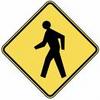 I was asked two interesting questions via e-mail this week: “Is it law or simply a rule in BC that pedestrians should walk facing the traffic when there is no sidewalks along the roads? What happens when the highway maintenance company leaves no shoulder to walk on?” As I contemplate my answer, many thing run through my mind. How do we learn to be a safe pedestrian? How many people don’t know the rules for driver / pedestrian interaction? What are the risks in deciding to walk on or beside the highway?
I was asked two interesting questions via e-mail this week: “Is it law or simply a rule in BC that pedestrians should walk facing the traffic when there is no sidewalks along the roads? What happens when the highway maintenance company leaves no shoulder to walk on?” As I contemplate my answer, many thing run through my mind. How do we learn to be a safe pedestrian? How many people don’t know the rules for driver / pedestrian interaction? What are the risks in deciding to walk on or beside the highway?
As a good grandpa should, I take my grand daughters by the hand when we cross the street to get the mail. We stop at the edge of the pavement and carefully look both ways. If nothing is coming, we walk directly across the road without hesitation to the opposite shoulder. If something is coming, we wait until the vehicle has passed before we cross. Their mother is equally careful. She coaches them to use the left side of the road to walk on and calls them to the side to stand and wait if a vehicle should appear. This is likely the most common form of pedestrian education.
ICBC provides a wealth of material to schools, free of charge, for road safety education. A quick check with my local school district reveals that road safety is not part of the curriculum, but students may earn credit toward graduation through completion of a certified driver training program. Use of these materials at school would be discretionary.
A search for resources on the internet will find many pages with tips for being a safe pedestrian but I was unable to find a comprehensive pedestrian guide for British Columbia. Sadly, there is the Auto Accident Survivors Guide for British Columbia that was written by a pedestrian with first hand knowledge of being struck and seriously injured.
Sections 179 to 182 of the Motor Vehicle Act is the law in B.C. that regulates how drivers and pedestrians must behave. The heaviest onus is on the driver to be aware of and exercise due care to avoid a collision. The other side of the coin requires pedestrians to use a sidewalk when one is available, to walk on the left facing traffic when there isn’t and to yield to vehicles when not using a crosswalk.
If there is no sidewalk and the shoulder is either impassable or not present, pedestrians are entitled to use the left edge of the roadway. Facing oncoming traffic will allow you to see approaching vehicles and take evasive action if necessary.
We have come from a society that was pedestrian based to one that is motor vehicle based with little provision for the safety of non-vehicle road users. That is starting to change however. The Canadian Council for Motor Transport Administrators has published Countermeasures to Improve Pedestrian Safety in Canada to guide authorities in fostering highways that are meant for more than the exclusive use of drivers.
Being a pedestrian comes with significant risk that it is possible many do not stop to consider. After all, most of us can walk by the age of two and move on to worry about other things. Still, 58 people are killed and 2,400 injured each year in B.C. The major contributing factors are distracted driving and drivers failing to yield the right of way but being a savvy pedestrian can go a long way toward self preservation.
Links:
Thanks for this topic. We walk daily on rural roads with no sidewalks and narrow shoulders. In winter months we wear HI VIS jackets and almost allways walk off the pavement /or stop when vehicles approach in our lane. Often there is a cyclist in the opposite lane,and traffic has to slow down-some drivers stop in this case .Some rip by.
I'm a bit dismayed that some social walkers walk side by side on the pavemnt and expect all traffic to drive around them.Worse yet are cyclist who travel on narrow roads and hills and ride side by side, slowing traffic until there is a safe place to pass.
In there some duty under BC traffic laws which goverens the occupation of the paved section of rural roads by pedestrians and cyclists riding side by side.?
- Log in to post comments
It is spelled out succinctly for cyclists:
Rights and duties of operator of cycle
183 (2) A person operating a cycle
(d) must not ride abreast of another person operating a cycle on the roadway,
They could ride side by side if the shoulder is wide enough or if one is on the roadway and one is on the shoulder.
It can be inferred for the pedestrian:
Pedestrian walking along highway
182 (2) If there is no sidewalk, a pedestrian walking along or on a highway must walk only on the extreme left side of the roadway or the shoulder of the highway, facing traffic approaching from the opposite direction.
If you are walking beside someone, you are not on the extreme left side.
- Log in to post comments
- Log in to post comments

walking on side of road